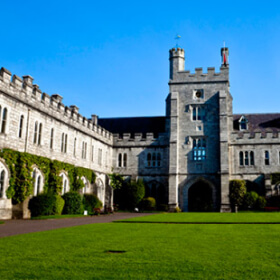Duckweed on a large scale
Large numbers of laboratory studies have reported that duckweed can be grown on various types of wastewaters, a process with substantial benefits for waste clean-up and waste valorisation. Many of these studies use small scale experiments, growing duckweed on laboratory scale volumes of wastewater. However, there is a marked lack of expertise in Europe in culturing duckweed on a large scale. One of the few exceptions was the AquaSus project in Ireland (now finished). The AquaSus project facilitated the development of a duckweed-based system of water remediation supporting an Integrated MultiTrophic Aquaculture (IMTA) fish farm. In this system, the culture of fish is linked to duckweed-based wastewater remediation. Duckweed in channels with a total surface area of one hectare are used to cleanse the recirculating water from 4 large fishponds containing 30 tonnes of rainbow trout.
 Scematic overview of the combined fish farm and duckweed canals.
Scematic overview of the combined fish farm and duckweed canals.
Based on the duckweed biomass produced, as well as its nitrogen and phosphorus content, it is calculated that the duckweed channels can remove 1.55 tonnes of nitrogen and 0.20 tonnes of phosphorus per year. Water analysis is carried out regularly at the inflow and outflow of the duckweed channels to assess the capacity of the system for water remediation, and duckweed is found to clean water effectively and to a high standard. In fact, it is estimated that the fish release similar amounts of nitrogen and phosphorus in the water. Thus, there is a good balance between water-fouling fish and water-cleansing duckweed.
However, this is not the full story: The annual duckweed biomass production at the AquaSus fish farm is estimated to be around 30 tonnes dry matter per year. This biomass has a protein content ranging from 30 to 40% of dry weight and is suitable as a component of animal feed.
 Aerial photo of the duckweed canals at the Mt Lucas fish farm.
Aerial photo of the duckweed canals at the Mt Lucas fish farm.
Important practical expertise was acquired as part of the AquaSus project, and it was demonstrated that large scale duckweed cultures can be successfully grown in Ireland. Several duckweed projects are following on from AquaSus: Duck Feed, Impress and Circular-IMTA-Demo. As part of these projects, the team are moving on to pioneer and upscale duckweed growth, remediation and waste valorisation on different agricultural, fish, and seafood processing wastewaters, and investigating the potential of using the duckweed biomass, for example as an animal feed component.
Paolacci, S., Stejskal, V., Toner, D. and Jansen, M.A.K, 2022. Wastewater valorisation in an integrated multitrophic aquaculture system; assessing nutrient removal and biomass production by duckweed species. Environmental Pollution, 302, p.119059.
Stejskal, V., Paolacci, S., Toner, D. and Jansen, M.A.K, 2022. A novel multitrophic concept for the cultivation of fish and duckweed: A technical note. Journal of Cleaner Production, 366, p.132881.


